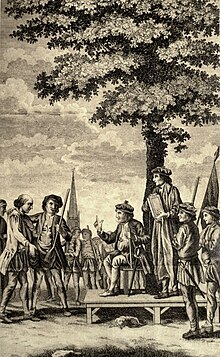
Back تمرد كيت Arabic شورش کت Persian Révolte de Kett French Кет Роберт көтерілісі Kazakh 케트의 난 Korean Powstanie Ketta Polish Rebelião de Kett Portuguese Восстание Роберта Кета Russian Kett's Rebellion SIMPLE Kett's Rebellion Swedish
| Kett's Rebellion | |||||||
|---|---|---|---|---|---|---|---|
 Robert Kett and his followers on Mousehold Heath (from Kett's Rebellion in Norfolk (1859)) | |||||||
| |||||||
| Belligerents | |||||||
| East Anglian rebels |
| ||||||
| Commanders and leaders | |||||||
| Robert Kett | |||||||
| Strength | |||||||
| ~16,000 rebels |
| ||||||
| Casualties and losses | |||||||
| ~250 killed | ||||||
| ~3,250 deaths | |||||||
Kett's Rebellion was a revolt in the English county of Norfolk during the reign of Edward VI, largely in response to the enclosure of land. It began at Wymondham on 8 July 1549 with a group of rebels destroying fences that had been put up by wealthy landowners. One of their targets was yeoman Robert Kett who, instead of resisting the rebels, agreed to their demands and offered to lead them. Kett and his forces, joined by recruits from Norwich and the surrounding countryside and numbering some 16,000, set up camp on Mousehold Heath to the north-east of the city on 12 July.
The rebels stormed Norwich on 29 July and took the city. On 1 August the rebels defeated a Royal Army led by the Marquess of Northampton who had been sent by the government to suppress the uprising. Kett's rebellion ended on 27 August when the rebels were defeated by an army under the leadership of the Earl of Warwick at the Battle of Dussindale. Kett was captured, held in the Tower of London, tried for treason, and hanged from the walls of Norwich Castle on 7 December 1549.